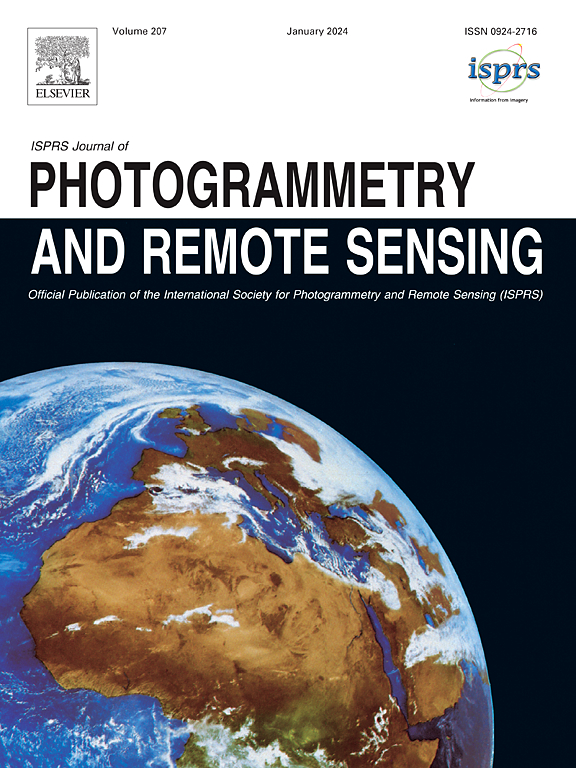Word2Scene:通过混合智能和低秩表示,仅用一个词就能高效生成遥感图像场景
IF 10.6
1区 地球科学
Q1 GEOGRAPHY, PHYSICAL
ISPRS Journal of Photogrammetry and Remote Sensing
Pub Date : 2024-11-06
DOI:10.1016/j.isprsjprs.2024.11.002
引用次数: 0
摘要
针对目前遥感场景生成方法中存在的诸多挑战,如难以捕捉地理特征之间复杂的相互关系、将隐含的专家知识融入生成模型等,本文提出了一种利用混合智能和低秩表示生成遥感场景的高效方法,命名为 "Word2Scene",只需一个单词即可生成复杂的场景。该方法结合地理专家知识优化遥感场景描述,提高了输入描述的准确性和可解释性。通过采用基于混合智能和低秩表示技术的扩散模型,该方法赋予了扩散模型理解遥感场景概念的能力,并显著提高了扩散模型的训练效率。本研究还引入了地理场景整体感知相似度(GSHPS),这是一种新颖的评价指标,可从全局角度全面评估生成模型的性能。实验结果表明,我们提出的方法在遥感场景生成质量、效率和逼真度方面都优于现有的先进模型。与原始的扩散模型相比,LPIPS 降低了 18.52%(从 0.81 降至 0.66),GSHPS 提高了 28.57%(从 0.70 升至 0.90),验证了我们方法的有效性和先进性。此外,Word2Scene 还能生成训练集中没有的遥感场景,展示了强大的零拍摄能力。这为遥感图像场景生成提供了新的视角和解决方案,有望推动遥感、地理信息系统及相关领域的发展。我们的代码将在 https://github.com/jaycecd/Word2Scene 上发布。本文章由计算机程序翻译,如有差异,请以英文原文为准。
Word2Scene: Efficient remote sensing image scene generation with only one word via hybrid intelligence and low-rank representation
To address the numerous challenges existing in current remote sensing scene generation methods, such as the difficulty in capturing complex interrelations among geographical features and the integration of implicit expert knowledge into generative models, this paper proposes an efficient method for generating remote sensing scenes using hybrid intelligence and low-rank representation, named Word2Scene, which can generate complex scenes with just one word. This approach combines geographic expert knowledge to optimize the remote sensing scene description, enhancing the accuracy and interpretability of the input descriptions. By employing a diffusion model based on hybrid intelligence and low-rank representation techniques, this method endows the diffusion model with the capability to understand remote sensing scene concepts and significantly improves the training efficiency of the diffusion model. This study also introduces the geographic scene holistic perceptual similarity (GSHPS), a novel evaluation metric that holistically assesses the performance of generative models from a global perspective. Experimental results demonstrate that our proposed method outperforms existing state-of-the-art models in terms of remote sensing scene generation quality, efficiency, and realism. Compared to the original diffusion models, LPIPS decreased by 18.52% (from 0.81 to 0.66), and GSHPS increased by 28.57% (from 0.70 to 0.90), validating the effectiveness and advancement of our method. Moreover, Word2Scene is capable of generating remote sensing scenes not present in the training set, showcasing strong zero-shot capabilities. This provides a new perspective and solution for remote sensing image scene generation, with the potential to advance the development of remote sensing, geographic information systems, and related fields. Our code will be released at https://github.com/jaycecd/Word2Scene.
求助全文
通过发布文献求助,成功后即可免费获取论文全文。
去求助
来源期刊

ISPRS Journal of Photogrammetry and Remote Sensing
工程技术-成像科学与照相技术
CiteScore
21.00
自引率
6.30%
发文量
273
审稿时长
40 days
期刊介绍:
The ISPRS Journal of Photogrammetry and Remote Sensing (P&RS) serves as the official journal of the International Society for Photogrammetry and Remote Sensing (ISPRS). It acts as a platform for scientists and professionals worldwide who are involved in various disciplines that utilize photogrammetry, remote sensing, spatial information systems, computer vision, and related fields. The journal aims to facilitate communication and dissemination of advancements in these disciplines, while also acting as a comprehensive source of reference and archive.
P&RS endeavors to publish high-quality, peer-reviewed research papers that are preferably original and have not been published before. These papers can cover scientific/research, technological development, or application/practical aspects. Additionally, the journal welcomes papers that are based on presentations from ISPRS meetings, as long as they are considered significant contributions to the aforementioned fields.
In particular, P&RS encourages the submission of papers that are of broad scientific interest, showcase innovative applications (especially in emerging fields), have an interdisciplinary focus, discuss topics that have received limited attention in P&RS or related journals, or explore new directions in scientific or professional realms. It is preferred that theoretical papers include practical applications, while papers focusing on systems and applications should include a theoretical background.
 求助内容:
求助内容: 应助结果提醒方式:
应助结果提醒方式:


